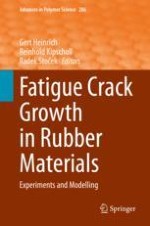2021 | OriginalPaper | Chapter
New Approaches to Modeling Failure and Fracture of Rubberlike Materials
Author : K. Y. Volokh
Published in: Fatigue Crack Growth in Rubber Materials
Publisher: Springer International Publishing
Activate our intelligent search to find suitable subject content or patents.
Select sections of text to find matching patents with Artificial Intelligence. powered by
Select sections of text to find additional relevant content using AI-assisted search. powered by
